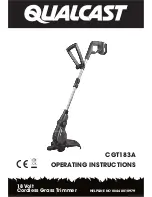
Hedge Cutter RC 162 11
VEHICLE / TRACTOR PREPARATION
We recommend vehicles are fitted with cabs
using ‘safety glass’ windows and protective
guarding when used with our machines.
Fit Operator Guard (See drawing) using
the hooks provided. Shape the mesh to cover
all vulnerable areas. The driver must be
looking through mesh and/or polycarbonate
glazing when viewing the working tool in any
working position - unless the vehicle/ cab
manufacturer can demonstrate that the penetration resistance is equivalent to, or
higher than, that provided by mesh/polycarbonate glazing. If the tractor has a roll bar
only, a frame must be made to carry both mesh and polycarbonate glazing. The
operator should also use personal protective equipment to reduce the risk of serious
injury such as; eye protection (mesh visor to EN1731 or safety glasses to EN166),
hearing protection to EN352, safety helmet to EN297, gloves and high visibility
clothing.
Vehicle Ballast
It is imperative when attaching ‘third-party’ equipment to a vehicle that the
maximum possible stability of the machine and vehicle combination is achieved
– this
can be accomplished by the utilisation of ‘ballast’ in order to counter-balance the
additional equipment added.
RC 162 has been tested on the following Arm systems:
Spearhead Twiga MID, PRO & Flex with tractors from 4400 kg, wheelbase of 250 cm
and a track width of 200 cm measured from / to the outer edge of the tire till tractors of
5500 kg , wheelbase of 280 cm and a track width of 250 cm measured from / to the
outer edge of the tire. Because there are different types of tractor structures and
differences in weight distribution you must view this as a "guideline". Is it possible, then
choose wide tires as possible to increase the stability of the vehicle.
Front weights
May be required for rear mounted machines to place 15% of total outfit
weight on the front axle for stable transport on the road and to reduce ‘crabbing’ due to
the drag of the cutting unit when working on the ground.
Rear weights
May be required to maintain a reasonable amount of rear axle load on the Opposite
wheel from the arms when in work; for normal off-ground work i.e. hedge cutting this
should be 20% of rear axle weight or more for adequate control, and for ground work
i.e. verge mowing with experienced operators, this can be reduced to 10%.
All factors must be addressed in order to match the type and nature of the equipment
added to the circumstances under which it will be used
– in the instance of Power Arm
hedge cutters it must be remembered that the machines centre of gravity during work
will be constantly moving and will differ from that during transport mode, therefore
balance becomes critical.
Summary of Contents for RC 162
Page 1: ......
Page 2: ......
Page 3: ...Hedge Cutter RC 162 3...
Page 50: ...50 Hedge Cutter RC 162...
Page 51: ...Hedge Cutter RC 162 51...
Page 52: ......












































